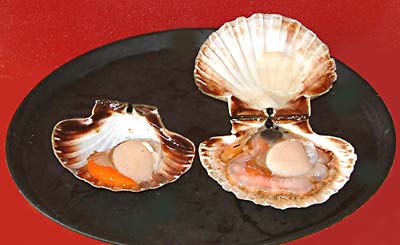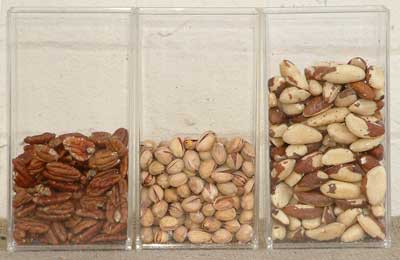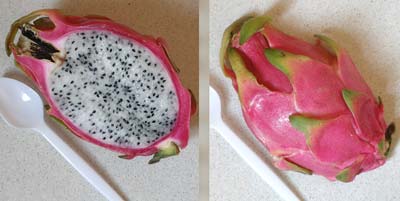Tree sparrow. Extraordinary to think of these birds as being eaten, but in times of food shortages they might be braised or cooked on a spit. How fortunate we are not to have lived in such hard times.

Pilgrim or great scallop. These are shellfish with white meats and pink corals, often cooked in their shells with the corals and have sweet, succulent meat if properly cooked. According to legend, the body of St James (St-Jacques) travelled with a boat with neither oars nor sails around the Iberian coast, coming to rest in Compostela. Many miracles were associated with this journey, including one where the horse of a pagan nobleman leaped into the sea. They emerged carrying the body of St James covered in scallop shells. This resulted in the nobleman converting to Christianity. Pilgrims to Santiago de Compostela have traditionally worn scallop shell badges in commemoration of St James, or used scallop shells as begging bowls. The whole pilgrim route is decorated with his emblem. In some parts of Europe they are eaten on the feast day of St James on 25 July to commemorate the arrival of pilgrims or peregrinos at Santiago de Compostela, often with tomatoes and garlic. They are more often simply and lightly fried.

Pistachio nut. The fruits of a small tree which originated in Central Asia, probably eastern Syria, but which is now widely cultivated. Just before harvest pistachios are enclosed in a green and magenta fleshy cover. These are the very best, if you can get them. However, fresh pistachios are rarely seen, mainly because they have a short shelf-life. They are usually hulled and dried, after which they are either roasted or roasted and salted. For cooking use the ones which are not already salted. They are sold in their creamy beige shells, which split as they ripen. The shells should be removed and the purple papery skins rubbed off revealing the bright green kernels within, the greener the better. They are related to both the cashew and the mango.

Pistachio nut. The fruits of a small tree which originated in Central Asia, probably eastern Syria, but which is now widely cultivated. Just before harvest pistachios are enclosed in a green and magenta fleshy cover. These are the very best, if you can get them. However, fresh pistachios are rarely seen, mainly because they have a short shelf-life. They are usually hulled and dried, after which they are either roasted or roasted and salted. For cooking use the ones which are not already salted. They are sold in their creamy beige shells, which split as they ripen. The shells should be removed and the purple papery skins rubbed off revealing the bright green kernels within, the greener the better. They are related to both the cashew and the mango.

Dragon fruit or pitaya. A striking purplish red or yellow fruit from Central America, twice the size of a passion fruit. It is pithy inside with an an unnaturally white sweet jelly with black pinpricks of edible seeds. I think it looks and tastes unnatural.
Planked steak. A steak grilled and served on a well seasoned hardwood board with grooves around the edges into which the meat juices drain.